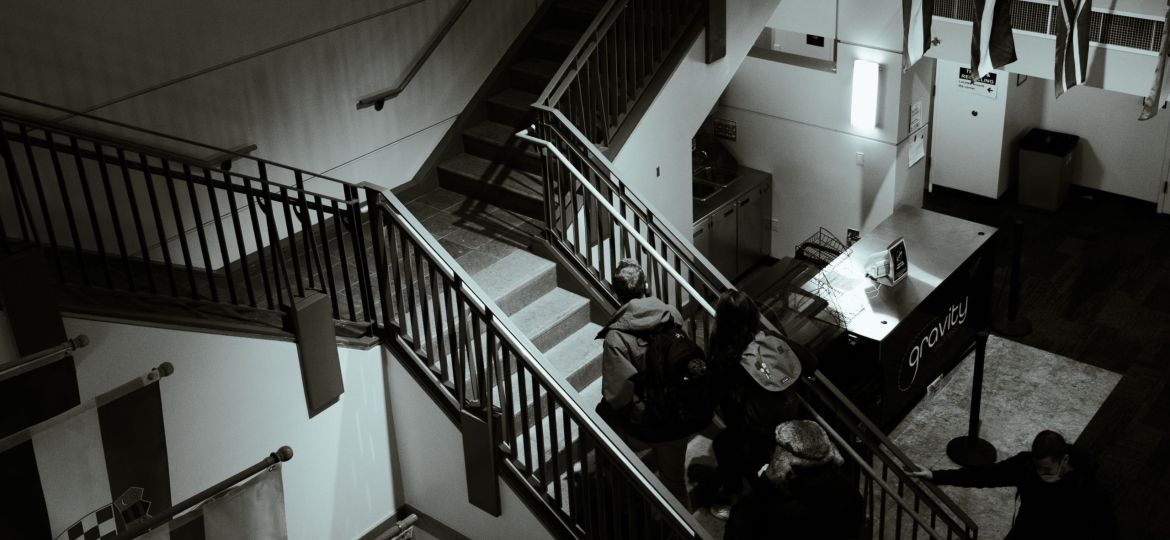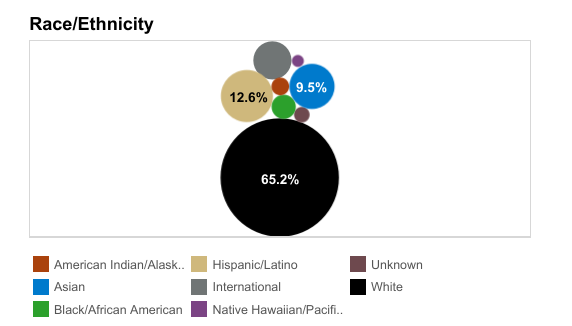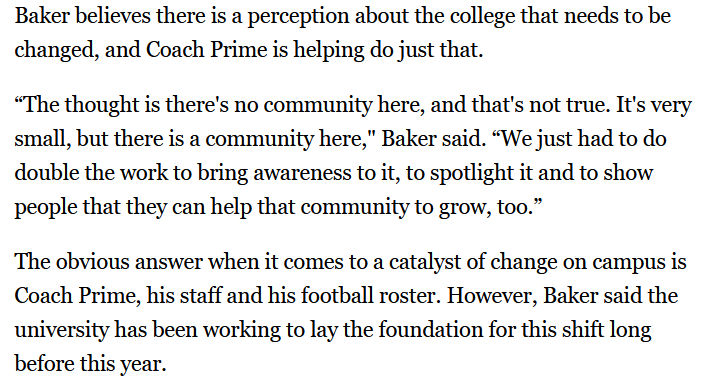
CU Boulder’s Problem With Diversity
When people think of Boulder, Colorado, what usually comes to mind is the pristine nature and the accepting atmosphere that welcomes guests and students alike. What is often overlooked or unnoticed in general, is the severe lack of diversity within the population of this community, specifically within the university setting.
The University of Colorado Boulder has a massive student body. With the number of students reaching close to 40,000, one might think the racial makeup of this school is one that is filled with diversity. In fact, that is not the case.
According to research conducted by the University of Colorado Boulder, the total student population for 2023 is 37,153 students with a total of only 1,015 making up the Black community. The number of Black students on campus is concerning, as it only equates to 2.7% of the total student body.

For reference, white students made up 65.2% of the same population pool.
Being a part of the Black community and being overshadowed by a predominantly white makeup has proved to be challenging for some students.
Tyler Brown, a newly transferred student and part of the acclaimed football team, expressed his thoughts when being made aware of the shocking statistics regarding his community at CU Boulder.
“That figure does not surprise me at all, it is what I expected,” Brown said.
Brown transferred from Jackson State University, a historically Black university, to CU Boulder, as a means to continue his love for the game of football. The difference in cultures is something Brown immediately noticed.
In relation to his transfer, he explained the shift in tradition coming from a predominantly Black school to a school where the student body doesn’t share the same culture to nearly the same extent was difficult.
“You just can’t beat an HBCU’s culture, um, you know, it can’t be reflected either. You can’t replicate tradition. I know that coming here, I would not get that.”
Being a football player at CU Boulder has highlighted the difference in being at a predominately Black school. Brown explains that he does not just want people to look at him as a football player solely, but as a human who wants to connect with others in the CU Boulder community.
“I do not like being put in a box, take the time to get to know me and have a conversation with me. There’s sometimes when I think that people just look at me and think I’m an athlete — no, there is way more depth to me as a person.”
What Brown is explaining is a common misconception swirling around campus that is situated within the larger issue of the lack of diversity that needs to be addressed more directly. There simply isn’t a highlighted sense of community for the Black population at CU Boulder, given the extremely small number of students.
In an interview conducted by Denver7 News with DaWon Baker, CU Boulder Assistant Athletic Director for Diversity, Equity and Inclusion, he states that, “The thought is that there is no community here, but that is not true. It is just very small.”

While students like Brown want others to see him outside his athletic career, staff members like AD Baker offer different insight to just how athletics — especially in the era of Deion Sanders — can escalate this sense of community for Black students.
In regard to the massive growth in student athletes and what that meant in relation to the rise in diversity, Baker says, “We just had to do double the work to bring awareness to it, to spotlight it, and to show people that they can help that community to grow too.” This work came in the form of an excelled sports program and support from other students.
What connects different groups of people and interconnects diversified relations on campus is when different social identities are acknowledged and celebrated. With CU Boulder being a school of such little diversity for the Black community, these social identities are something that staff members, faculty, and students want to bring to the attention of the community.
According to CU Boulder Diversity and Inclusive Excellence team member Craig Cook, being a staff member means he wants to excel in sharing aspects of his personal identity. This is so that he can connect to students who may be struggling with feeling othered.
In reference to his own community, Cook said, “Social identity as a faculty member is about the idea of letting people know that there are things on campus that they can associate with.”
Part of Cook’s social identity falls among traditions within the Black community that he wants to encourage others to embrace and make part of the CU Boulder community in general.
“Black student athletes, the Black community, we love music, and we love dancing. This was a part of how our community grew up, and we look for outlets to make this happen,” Craig said.
Creating these outlets and making them known to this community is vital for ensuring students are comfortable with their personal social identity that varies heavily when compared to the overwhelming white majority.
For students like Brown, acknowledging social identity means breaking out of the traditional stereotypes placed onto Black student athletes like himself.
“Who I am on the football field is not who I am in a classroom setting,” Brown said.
Being in a classroom setting with the lack of diversity among instructors has proven to be hard for Tyler as he heavily suggests that this university should “have more Black professors in the classroom, there should not just be five or six, if that.”
If there was more diversity in the classroom among professors, students like Brown would be able to share their social identity with someone who might understand them the most, rather than others who might not understand their experience as a Black student at CU Boulder.
This would also ensure that more Black students feel the need to continue their education and graduate at CU Boulder, as opposed to leaving the university due to the feeling of being out of place.
According to a study conducted by College Factual in relation to graduation rates at CU Boulder, 71% of Black students end up finishing their degree at and graduating from CU Boulder.
What the community at CU Boulder is failing to recognize is the reasoning for why there is not a near 100% graduation rate for the Black community. This is something Cook feels is a heightened issue for this community, as many students are choosing to leave this school due to a lack of connections being made.
“Our community goes on campus, tries to find their footing, and once they get that footing, a part of that community leaves because they believe there is no community here at all.”
What Cook is explaining is reminiscent of a theory called the Spiral of Silence Theory. This theory states that people remain silent when they feel like their views are in opposition to the majority viewpoint of a given subject. In the university setting at CU Boulder, this theory surrounds the Black community of students as they are overshadowed by the predominantly white population.
“Being an imposter is tough, you have to turn on and off everywhere you go until you go home, walk into the house and slam your door and can be yourself,” Craig said.
In order to make students feel comfortable here at CU Boulder, there has to be the implementation of representation for the Black community of students, and this comes in various forms.
What arises is the question of if the university is able to correctly support this community.
“It’s more of a Black student and faculty mindset — being able to look at students and being able to bypass biases. I don’t know if the university is capable of identifying a way for Black students to want to come here,” Craig said.
But, this in no way instills the conclusion that there aren’t measures the university and officials can take to integrate a more diverse network for students. Brown explains how there are drastic actions not being taken to make Black students feel more comfortable, and the correction of the issue starts with identifying key areas where inclusion can be implemented.
“Honestly, a lot of kids when they look at college brochures, they see pictures of the white students smiling and looking happy. Have more Black kids do that and show more Black students in the classroom that are not athletes.”
A core example of representation comes in the form of the university embracing Black culture. Tyler reflects on how last February, the university barely recognized Black History Month. In response to this, Tyler exclaimed how he wants to see this school “have more events where other kids can learn about our community.”
With a total faculty and staff at CU Boulder consisting of over 36,000 members, the adequate steps to take to ensure the Black community on campus feel welcome is not a far throw away. There are a plethora of officials at this university who can take a step in the direction of change and establishing community for Black students.
For more information on how students can find their community at CU Boulder, check out the Center for Inclusion and Social Change’s website or visit the center on campus, located in the Center for Community’s (C4C) Room N320.

